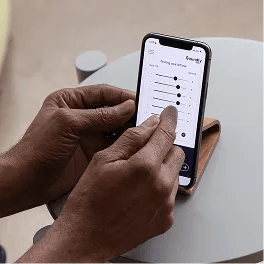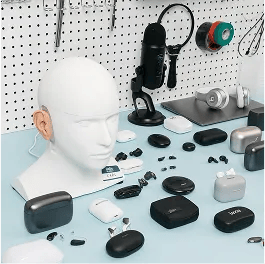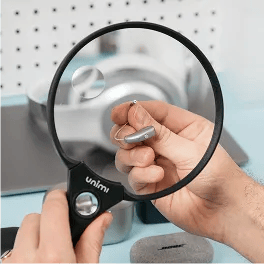Key Takeaways:
- Q-tip use can cause some not so pleasant side effects from eardrum perforations to wax impaction or minor injuries.
- Most people don't need to do anything special for ear cleaning: the ear is self-cleaning.
- For some, professional cleanings may be necessary on a regular basis (e.g., narrow ear canals or surgical ears)

Nestled in the nooks of many bathrooms, you'll find a familiar item – the seemingly innocuous Q-tip. It's a staple in many grooming routines, including a misunderstood area in ear care. For most of your life, you've probably been told not to use Q-tips to clean your ears. But why? And is there any truth behind the warnings from parents, doctors, and the infamous "Do Not Insert in Ear Canal" label?
I'm here to peel back the layers of ear care, and as an audiologist, poised to offer clear insights into the sometimes-controversial topic of at-home ear maintenance. In the world of audiology, cleaning ears is a frequent topic, and it's high time we distinguish fact from fiction concerning our trusty – or not so trusty – Q-tip.
Are Q-tips really dangerous for your ears?
The short answer is, yes. The contention against Q-tips in ear care is not new, nor is it ungrounded. The delicate nature of our ear canal, layered with a thin veil of sensitive skin, that leads down to the eardrum means any foreign objects – yes, even those soft cottony tips – can tip the balance towards irritation, injury, or, paradoxically, compounding the very issue they are meant to solve.
In this next section, we'll examine the myths and truths about earwax, shedding light on what it is, and why it's there.
The Worst that Could Happen: Ears and Q-tip Risks
Every year, emergency rooms (and some audiology or ENT clinics) witness an array of Q-tip-related injuries and complications: about 12,500 per year or 34 per day. I've seen some myself – from minor skin abrasions that lead to infection to perforated eardrums that sometimes mandate surgical intervention.
In this section, we'll outline in vivid clarity the dangers associated with Q-tip use and how these unfortunate events unfold. Stories of cotton swabs gone awry will serve as a cautionary tale.
Eardrum Perforation
Eardrum perforation can occur in the blink of an eye. Imagine—you're minding your own business, thoughts focused on the day ahead of you, then suddenly, out of nowhere, someone loudly knocks on the door or yells. This startles you, causing the Q-tip to move at high velocity straight for the eardrum. The immediate aftermath is often intense pain, a sudden onset of hearing loss in the affected ear, and sometimes even vertigo or ringing. These are clear signs that the eardrum has been damaged, prompting an urgent visit to the doctor. This scenario highlights the inherent risks of using Q-tips within the ear canal, underscoring the importance of adopting safer ear cleaning practices.
Minor Injuries
During otoscopy, I've regularly observed minor injuries to the ear canal from instances where the Q-tip jabbed a little too hard on the ear canal wall. Patients are often surprised when I identify the signs of Q-tip use – but as an audiologist, these indicators are clear. The ear canal's skin is extremely delicate and easily susceptible to abrasions. These seemingly minor injuries can lead to discomfort, and in cases where the skin is broken, they become gateways for infection.
Earwax Impaction
A common misconception is that using Q-tips for ear cleaning helps remove earwax effectively. However, this practice can lead to a counterproductive outcome: earwax impaction. Although it may seem like wax is being removed when examining a used Q-tip, the reality can be quite different. More often than not, the cotton swab pushes earwax deeper into the ear canal, where it becomes more difficult to naturally exit the ear. Over time, this can lead to the build-up of earwax, creating a blockage that can cause discomfort, reduce hearing capability, and sometimes result in tinnitus or earaches.
Earwax, or cerumen, serves as a natural protector of the ear, trapping dirt and slowing the growth of bacteria. When earwax is pushed back into the deeper parts of the ear canal, it can harden and stick to the skin, making it challenging to remove without professional help. This situation not only demonstrates the dangers associated with the misuse of Q-tips but also the need for safer, more effective methods for ear care.
The Right Way to Clean Your Ears
Given the risks, what is the safe way to manage ear hygiene at home? Fortunately, there are other methods that are safer and more effective than the beloved Q-tip. We'll introduce and explain these alternative approaches and how you'll be able to keep your ears in good shape without the overhanging specter of a trip to the doctor's office.
What Is Earwax?
Dispelling common misconceptions about earwax is vital for understanding the Q-tip dilemma. It's not 'dirt,' but a natural and necessary secretion that moisturizes, protects, and cleans our ears. We'll traverse through the mazes of the ear canal, explaining why earwax should not be feared.
Here is a short video that explains how earwax forms and the ear's self-cleaning mechanism:
Effective Ear Cleaning Practices
Understanding the necessity of maintaining proper ear hygiene while avoiding the pitfalls of Q-tip use leads us to safer and more effective alternatives. One such method is allowing warm water to gently flush the ear during regular showers. This process does not require direct water jets into the ear canal but rather letting water run in and out naturally, which can help in softening any accumulated wax.
Prior to this flushing process, using a few drops of mineral oil can significantly enhance the effectiveness of wax removal. The evening before your shower, apply a few drops of mineral oil into the ear canal, which acts to soften the wax overnight. This preparation makes it easier for the warm shower water to mobilize and flush out the softened wax the following morning.
For those requiring additional help beyond these methods, there are specialized tools designed for safe earwax removal. These tools are crafted to flush the ear canal gently, ensuring the removal of wax without causing harm to the ear's delicate structures. For a comprehensive guide on choosing and using these tools effectively, we invite you to read through our curated selection in our guide for the best earwax removal tools. This resource aims to equip you with knowledge and options, steering clear of the risks associated with incorrect ear cleaning practices and propelling you towards maintaining ear health with confidence and safety.
When to Call in the Professionals
Despite our best efforts at home, some ears are simply more challenging to keep clean owing to their unique anatomy, or some individuals are naturally more prone to wax buildup. If you find yourself struggling with recurring earwax impaction or discomfort despite following safe cleaning practices, it may be time to consider professional assistance. These healthcare professionals have the tools and expertise to safely remove earwax without damaging the ear canal or eardrum. This preventative measure not only ensures your ear health but also offers peace of mind, knowing your ears are being cared for by someone who thoroughly understands their intricacies.
Final Thoughts
In closing, our examination of Q-tip use for ear cleaning leads to a clear verdict: the risks far outweigh any perceived benefits. This exploration across the dangers of earwax impaction, the natural and necessary role of earwax, and safer, more effective ear cleaning practices underscores a pivotal shift needed in our approach to ear care. Remember, while Q-tips may seem like convenient tools, they're best left for crafts and cosmetics, not for venturing into the delicate ecosystems of our ears.

.jpg)




